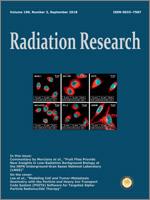During the pulsed-electron beam direct grafting of neat styrene onto poly(tetrafluoroethylene-co-hexafluoropropylene) (FEP) substrate, the radiolytically-produced styryl and carbon-centered FEP radicals undergo various desired and undesired competing reactions. In this study, a high-dose rate is used to impede the undesired free radical homopolymerization of styrene and ensure uniform covalent grafting through 125-μm FEP films. This outweighs the enhancement of the undesired crosslinking reactions of carbon-centered FEP radicals and the dimerization of the styryl radicals. The degree of uniform grafting through 125-μm FEP films increases from ≈8%, immediately after pulsed electron irradiation to 33% with the subsequent thermal treatment exceeding the glass transition temperature of FEP of 39°C. On the contrary, steady-state radiolysis using 60Co gamma radiolysis, shows that the undesired homopolymerization of the styrene has become the predominant reaction with a negligible degree of grafting. Time-resolved fast kinetic measurements on pulsed neat styrene show that the styryl radicals undergo fast decays via propagation homopolymerization and termination reactions at an observed reaction rate constant of 5 × 108 l · mol–1 · s–1. The proton conductivity of 25-μm film at 80°C is 0.29 ± 0.01 s cm–1 and 0.007 s cm–1 at relative humidity of 92% and 28%, respectively. The aims of this work are: 1. electrolyte membranes are prepared via grafting initiated by a pulsed electron beam; 2. postirradiation heat-treated membranes are uniformly grafted, ideal for industry; 3. High dose rate is the primary parameter to promote the desired reactions; 4. measurement of kinetics of undesired radiation-induced styrene homopolymerization; and 5. The conductivity of prepared membranes is on par or higher than industry standards.
How to translate text using browser tools
18 June 2018
Mechanisms and Characterization of the Pulsed Electron-Induced Grafting of Styrene onto Poly(tetrafluoroethylene-co-hexafluoropropylene) to Prepare a Polymer Electrolyte Membrane
Byungnam Kim,
Alia Weaver,
Marina Chumakov,
Ileana M. Pazos,
Dianne L. Poster,
Karen Gaskell,
Do Hung Han,
Günther Scherer,
Michael A. Yandrasits,
Byung Cheol Lee,
Mohamad Al-Sheikhly
ACCESS THE FULL ARTICLE

Radiation Research
Vol. 190 • No. 3
September 2018
Vol. 190 • No. 3
September 2018




